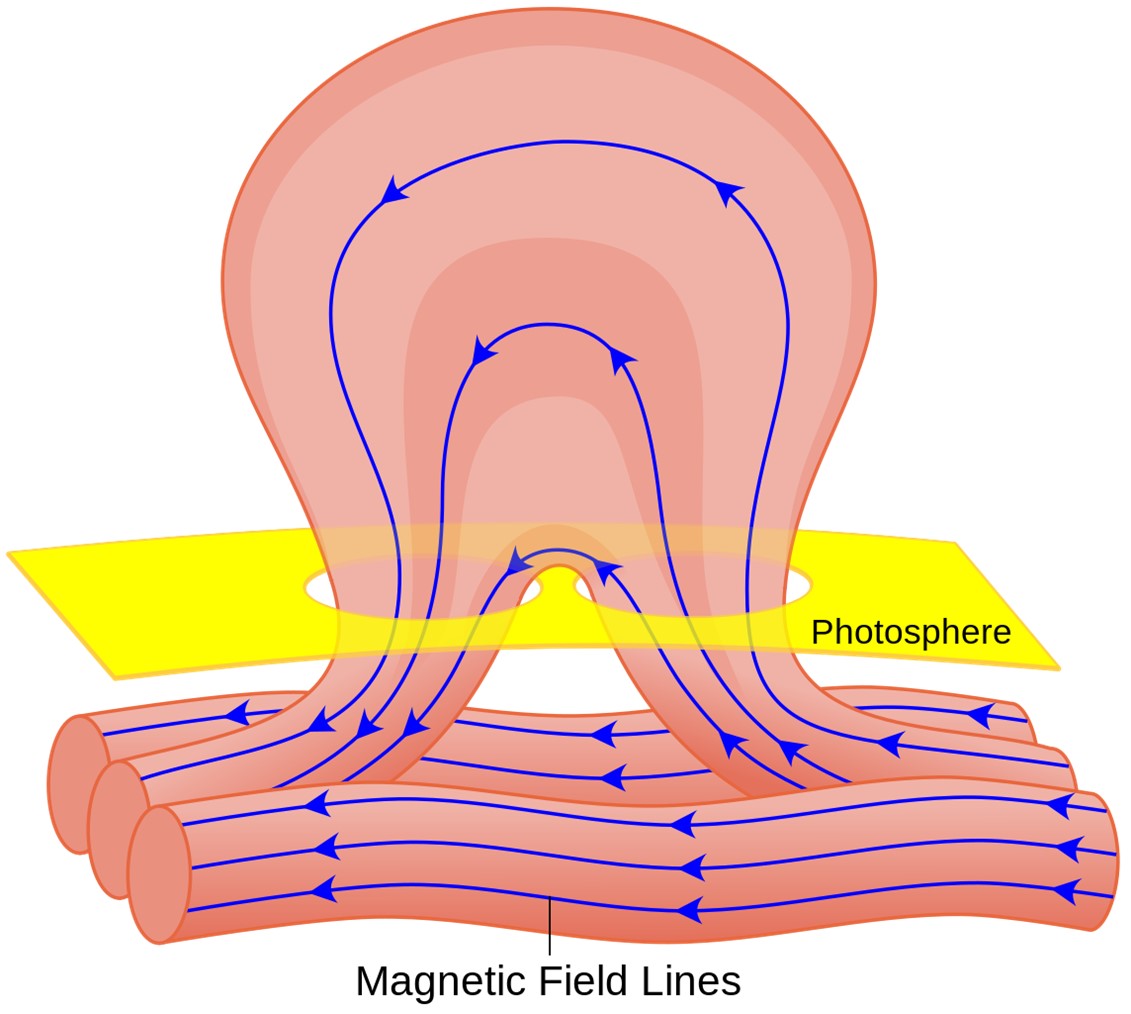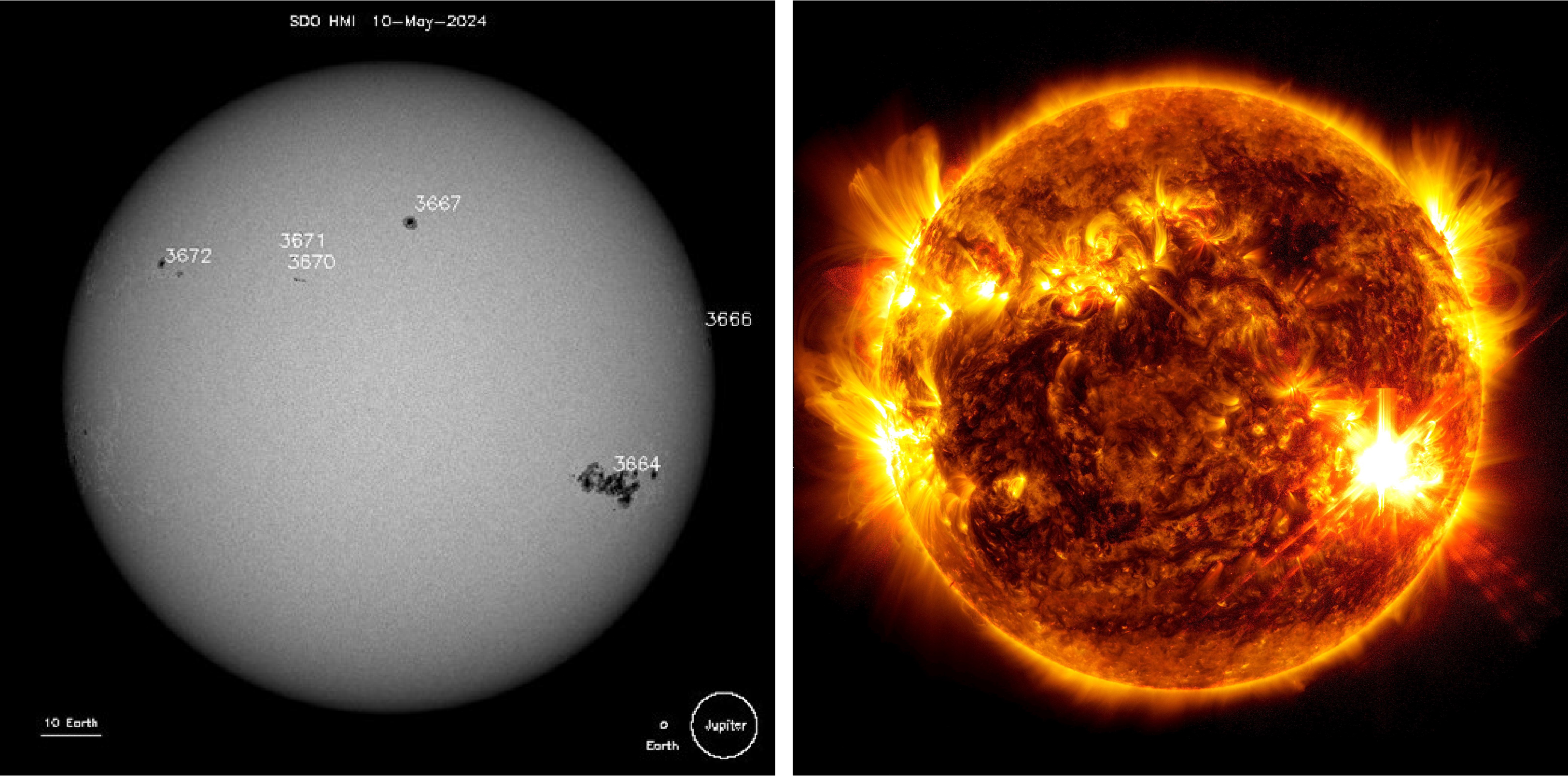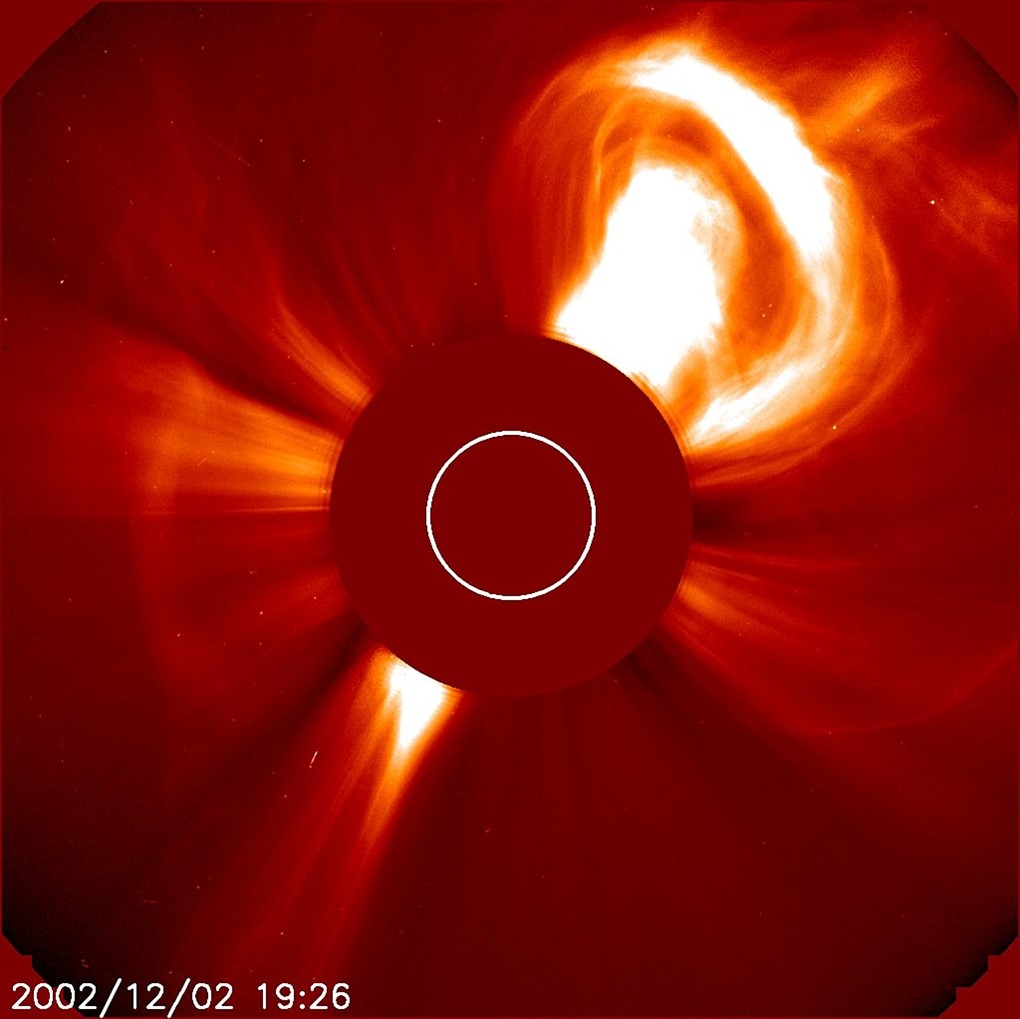
Credit: NASA
Solar flares and coronal mass ejections are the most powerful explosions in our solar system—too large, heavy and fast-moving to imagine. But they’re not the same thing.
They occur mostly when the Sun’s magnetic poles prepare to flip, every 11 years or so, in an event called a “solar maximum.” Magnetic fields deep within the Sun punch up to create two very different anomalies on the surface:
Solar flares are enormous flashes of broad-spectrum electromagnetic radiation, from radio waves to gamma waves, released with the force of billions of hydrogen bombs.
They stay largely within the Sun’s atmosphere, but when their energy does reach Earth, traveling at nearly 700 million miles an hour, it can degrade radio communications and black out navigation.
Coronal mass ejections are made up of matter, not radiation, and instead can contain a billion tons of superheated solar plasma.
Some collapse back into the Sun, but others leave the Sun’s atmosphere and enter space.
There they could expand to a million miles wide. Traveling at speeds of only a few million miles an hour, they can reach Earth in around 15 hours …
where they can cause amazing auroras—northern and southern lights—as well as interfere with power grids, as we’ve discussed on prior episodes.
Fortunately, NASA has built a satellite early warning system so we can prepare our critical infrastructure for this powerful solar weather.
Background
Synopsis: During the solar maximum of Solar Cycle 25 in 2024, Earthlings have enjoyed beautiful auroras and experienced minor radio wave outages as our sun has thrown different types of electromagnetic energy toward Earth. Solar flares and coronal mass ejections exhibit similarities, but they are different.
- The year 2024 has witnessed the maximum of Solar Cycle 25, and May was a particularly solar-stormy month.
- A solar storm began on May 7 with two strong solar flares.
- In the second week of May, more than 82 notable solar flares occurred, and at least eight of these were the strongest type, X-class flares. The strongest that week was an X8.7 flare on May 14.
- In the same time frame, seven waves of powerful coronal mass ejections (CMEs) blasted toward Earth at speeds of up to 3 million mph (4.8 million kph).
- This activity produced the first G5-level geomagnetic storm in more than 20 years, with a similar impact as geomagnetic storms in 2003 and 1958.
- Auroras were visible as far south as 26° magnetic latitude.
- The culmination of all this solar activity will be a polarity reversal of the Sun’s magnetic field sometime between June and November of 2024. The previous solar magnetic field flip was in 2013, and this happens every time there is a solar maximum, about every 11 years.
- The Sun’s surface is very dynamic as the constant movement of electrically charged gases generates powerful magnetic fields.
- The constant movement of the Sun’s gases contorts, tangles and twists its magnetic fields, rising up to the surface to cause solar activity, which produces sunspots. Sunspot observations are used to gauge the intensity of solar maxima (ED-126 Two Sides of the Sun).
- Sunspots are localized strong magnetic fields that punch upward from deep within the Sun, hindering the normal transfer of energy, including light and heat.
- Sunspots can last days to weeks and appear dark because they are cooler (6,300°F [3,500°C]) than the surrounding surface of the Sun (9,900°F [5,500°C]).

This diagram shows the magnetic line structure of a solar flare and its origin caused by deformation of the magnetic field lines extending from the interior to the atmosphere (corona) of the Sun.
Credit: TilmannR, CC0, via Wikimedia Commons - Sunspots accumulate magnetic energy that is finally released when magnetic fields explosively realign, blasting vast amounts of energy outward in the form of solar flares and CMEs.
- Solar flares and CMEs are the most powerful explosions that happen in our solar system, but they are not the same thing.
- They are both solar phenomena during which excited particles are accelerated violently away from the Sun, but they look different, they travel at different speeds, they emit different contents and they impact planets differently.
- Sometimes solar flares and CMEs happen at the same time, and the strongest flares are almost always associated with CMEs. But sometimes CMEs occur without a solar flare. Scientists are still trying to understand the relationship between powerful solar phenomena like these.
- If a solar flare can be likened to the muzzle flash of a cannon, a CME can be likened to a cannonball, but not all flashes result in cannonballs.
- The Difference Between CMEs and Solar Flares | NASA Video
- A solar flare is a brief, brilliant flash of electromagnetic radiation across the entire spectrum from radio waves to gamma waves.
- Solar flares occur near sunspots and last for minutes to hours, rapidly releasing energy comparable to billions of hydrogen bombs and extending principally within the Sun’s atmosphere (corona).
- Photons of light from solar flares travel at the speed of light, 671 million mph (1.08 billion kph), making it from the Sun to Earth in 8.3 minutes. Associated very high energy particles may reach Earth tens of minutes after the eruption.
- Flares are rated on a logarithmic scale like earthquakes, starting with A-class (background level) to B-, C-, M- and X-class, with each letter progressively representing a tenfold increase in energy output.
- Solar flares can disrupt Earth’s ionosphere, degrading radio wave communication and causing temporary blackouts in communication and navigation.

Left: Sunspots on May 10, 2024.
Right: NASA’s Solar Dynamics Observatory captured this image of an X5.8 solar flare peaking at 9:23 p.m. EDT on May 10, 2024. Note the correlation between sunspot areas and solar flares. The image shows a subset of extreme ultraviolet light (beyond the visible spectrum) that highlights the extremely hot material in flares, prominences and the chromosphere, and which is colorized in orange–red.
Left Credit: Solar and Heliospheric Observatory, ESA and NASA
Right Credit: NASA Solar Dynamics Observatory
- When magnetic fields become really knotted up, the Sun basically needs to “burp,” so it hurls magnetized clouds of matter called CMEs into space.
- These CMEs contain about a billion tons of superheated solar plasma, including their embedded magnetic fields.
- They occur over several hours and may be associated with solar flares, filaments or prominences.
- Some CMEs collapse back into the Sun, while others are accelerated beyond the Sun’s corona into interplanetary space along a straight path.

This image shows a very large CME blasting off into space on December 2, 2002. It presents the classic shape of a CME: a large bulbous front with a second, more compact, inner core of hot plasma. This material erupts away from the Sun at speeds of more than one million miles (or kilometers) per hour. The size of the Sun is the white circle, while the donut around the circle covers the Sun’s corona to provide a better view of the CME.
Credit: Solar and Heliospheric Observatory, ESA and NASA - These huge, magnetized blobs of plasma (energized gas particles consisting mainly of protons and electrons) expand to as much as 1 million mi wide (1.6 million km) as they propagate away from the Sun.
- Because they are particle radiation, CMEs travel much slower than electromagnetic radiation in solar flares.
- They move at speeds of 1 million to 7 million mph (1.5–11 million kph), taking as little as 15 hours or as much as 3 days to reach Earth if the CME is ejected in our direction. This gives us time to prepare for their arrival.
- If aimed at Earth, CMEs can trigger auroras as they interact with our magnetic field, and they may interfere with power grids and damage satellites in their path.
- Today, because of dangers to modern technology, NASA has a fleet of heliophysics spacecraft that monitors the Sun to predict solar weather, providing “24–7” reports similar to meteorological weather forecasts.
- The largest known CME event to strike Earth, the 1859 Carrington Event (ED-211 Solar Superstorm) catastrophically disrupted telegraph systems and produced auroras as far south as Hawai‘i and the Caribbean.
- In 1972, a CME disrupted phone lines in Illinois, while a 1989 event melted transformers in New Jersey and knocked out power for 6 million people in Quebec for 9 hours. In 2003, a Halloween storm knocked out power and shut down some satellites, and in 2006, satellite communications were interrupted and GPS systems were disrupted for 10 minutes (ED-011 Magnetic Storms).
- Back then, we didn’t have a system that could warn us about incoming CMEs, giving us time to protect sensitive infrastructure.

NASA’s Solar Dynamics Observatory Satellite is part of the “Living With a Star” Program, along with other satellites.
Credit: NASA, Public domain, via Wikimedia Commons - But now we do. Today, advanced notice from NASA, NOAA and other agencies enables operators to protect electrical grids, satellites and communication and navigation systems.
- Some activities can be paused until solar activity abates. On May 10, 2024, farmers had to shut down the planting of crops because GPS navigation of farm machinery was as much as 10 ft (3 m) off when they need inches of accuracy. Flight planners pushed flights farther south to avoid communication and navigation blackouts more typical near the poles.

